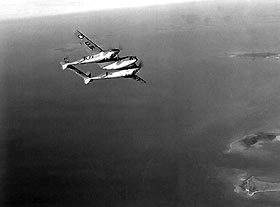
Enregistrez gratuitement cette image
en 800 pixels pour usage maquette
(click droit, Enregistrer l'image sous...)
|
|
Réf : S04305
Thème :
Aviation - Avions NASA-Prototypes (1538 images)
Titre : Lockheed P-38 Lightning in flight
Description : (La description de cette image n'existe qu'en anglais)
The P-38 shown in this photo was one of the fighters built in the late 1930s and early 1940s that experienced compressibility effects. In steep dives, these aircraft could reach speeds above Mach 0.75 (called transonic). At transonic speeds, air in front of the wings became compressed and reached supersonic speeds as it flowed over the wings, forming a shock wave. This resulted in an increase in drag and a decrease in lift. Another result was the movement of the wing's center of lift to the rear, forcing the aircraft to rotate so that the nose moved downward and it went into a steep dive. Pilots found that that their aircraft would not pull out of this dive. When they attempted to pull out, they found the control stick, as one pilot put it, ''was cast in about two feet of concrete.'' In some cases, the airplanes crashed or broke up in the denser air as they approached the ground. In other cases, the pilots were able to pull out of the dive. These accidents and near misses reinforced the popular belief in a ''sound barrier.'' The need for data at speeds near that of sound and the inability of wind tunnels at the time to provide it would lead to the construction and flight of the X-1 and D-558 research aircraft.
|
|

